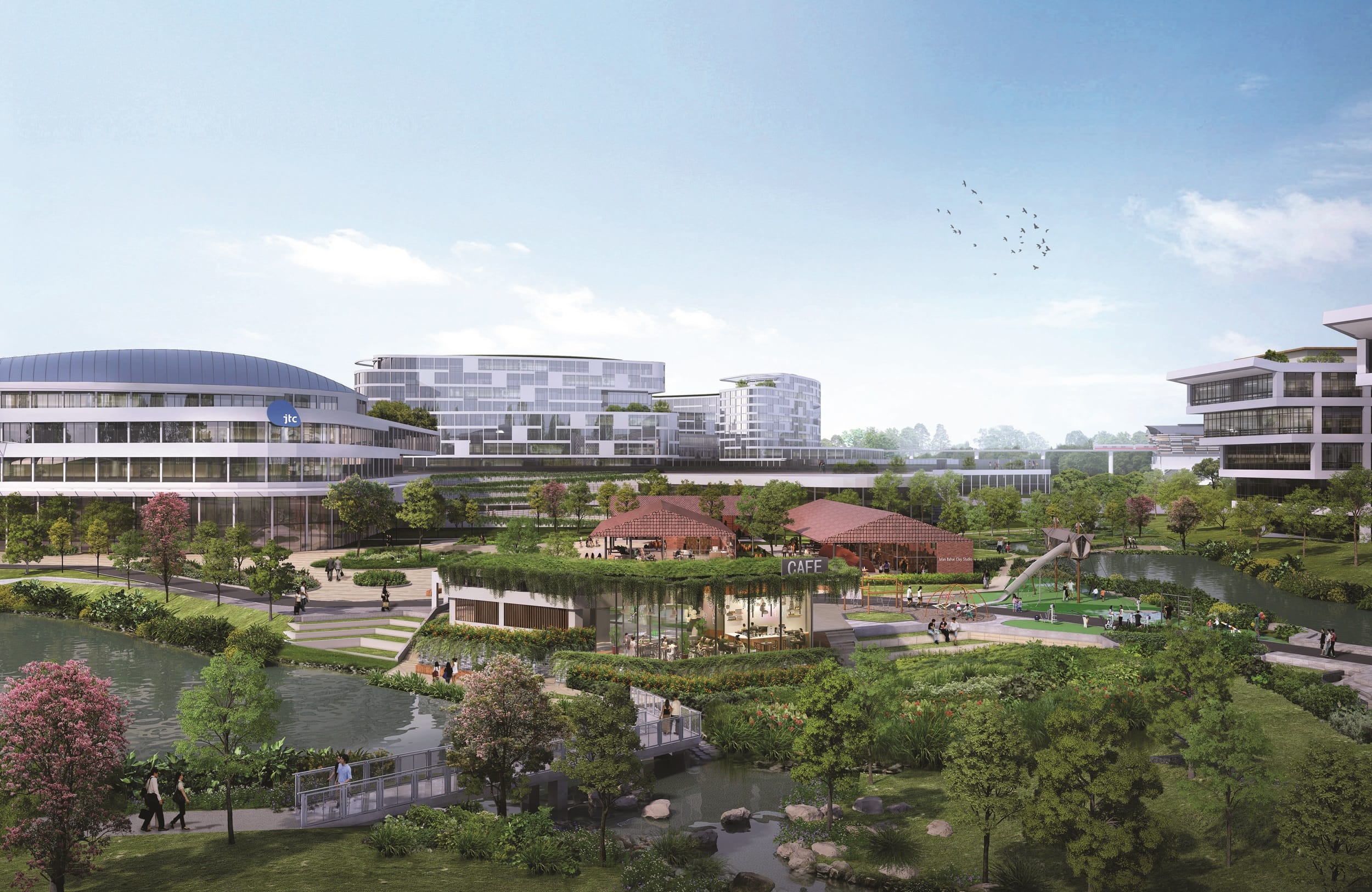- Home
- Regional Plans
- West Region
- Future-ready Sustainable Economic Hub
Future-ready Sustainable Economic Hub
Anchored by Jurong Lake District, Jurong Innovation District and Tuas Port, the West Region will continue to be one of Singapore‘s key economic engines.
Facilitating future industries
Anchored by Jurong Lake District, Jurong Innovation District and Tuas Port, the region will continue to be Singapore‘s key economic engine. Synergistic industries and world-class universities enable businesses in these nodes to easily tap on a ready ecosystem of talent. The business and job nodes in the region will continue to grow with improved public transport connectivity and infrastructure.

Supporting Singapore’s sustainability aspirations
Renewable energy sources in the West Region include land-based solar farms and floating solar photovoltaic systems (e.g. at Tengeh Reservoir). The region also houses hydrogen-ready power plants on Jurong Island which can support Singapore’s clean energy transition. Subsea cable landing sites at various locations in the region have also been identified to facilitate the import of green energy from neighbouring countries.

Jurong Lake District
Singapore’s largest business district outside the city centre
Jurong Lake District (JLD) is transforming into a vibrant mixed-use district for live, work and play to support office decentralisation. Many developments and infrastructure projects (e.g. Jurong Gateway Hub, Jurong Region Line and Cross Island Line Phase 2) that support its growth are being implemented. A 6.5-hectare Master Developer site next to Jurong East MRT Station is on the Reserve List of the Government Land Sales programme to allow interested tenderers to activate its launch. Comprising a mix of office, housing, retail, hotel and other complementary uses, it will kickstart the district’s next phase of development.

A model for urban sustainability and healthy living
JLD aims for net zero emissions for new developments by 2045, five years ahead of the national target. This will be achieved by reducing energy consumption, improving energy efficiency, cutting carbon emissions and fostering new partnerships and innovation.
All new developments will be required to minimally achieve BCA’s Green Mark Platinum Super Low Energy rating. They will also use the District Cooling System to cool their buildings and the District Pneumatic Waste Conveyance System for better waste handling and management. Solar energy will be optimised on all suitable surfaces. By 2035, at least 85% of commuting trips in the district will be made through walking, cycling or public transport modes, supported by multi-level pedestrian linkages, an extensive cycling path network, bus lanes/ bus-only roads, and four MRT lines.

How a typical development in JLD could bring together various sustainability aspirations.

Improving wayfinding in Jurong and beyond
Apart from being a model for urban sustainability and healthy living, JLD also serves as a “living laboratory” for piloting new urban solutions and sustainability-centric initiatives. For example, pedestrians can easily navigate within and around buildings in JLD through an indoor way-finding tool by Mapxus, a winner of the 2023 JLD Innovation Challenge organised by the URA, Smart Nation Singapore and Infocomm Media Development Authority. The tool has now been implemented in various developments across Singapore, including Jewel Changi, AMK Hub and National University Hospital. (Source: Mapxus)
Jurong Innovation District
Fostering innovation in response to a changing industrial landscape
Jurong Innovation District is home to high-tech advanced manufacturing firms across the entire industry value chain, from research and development to prototyping and manufacturing. Key players in the district include Shimano, Makino, Hyundai Motor and A*STAR.
The district will house innovative infrastructure, such as an 11 kilometre-long Sky Corridor that connects various developments. An extensive underground District Logistics Network will enhance the efficiency of freight movement and help reduce traffic above ground.

Attractive business spaces at Jurong and Tuas transport nodes
Business-White plots will be introduced around key public transport nodes in the Jurong and Tuas industrial estates, providing greater flexibility to house a bigger proportion of non-industrial uses and introducing complementary amenities to serve workers and the public.
Tuas Port
Smarter, greener and ready for the future
Tuas Port will be connected to Jurong Lake District, Jurong Innovation District and the Jurong/Tuas Industrial Estates to form a well-integrated ecosystem with businesses that have high levels of interactions with the port. The close proximity to the port will enable these businesses to easily tap on the port’s global connectivity and unlock supply chain synergies to generate more efficient trade flows.

A key development within Tuas Port is the PSA Supply Chain Hub @ Tuas (PSCH) which will expand PSA’s suite of innovative supply chain solutions to meet the evolving demands of global trade. Scheduled to be operational by 2027, the technologically advanced facility will host a comprehensive suite of value-added services to integrate seamlessly with Singapore’s extensive supply chain ecosystem including a Regional Distribution Centre, Container Freight Station, Automated Storage and Retrieval System (ASRS), and Intelligent Warehouse eXchange (iWX).
Tuas Port will reimagine its operations from the ground up. Versatile and highly adaptable to dynamic environments, the electric Automated Guided Vehicles (AGVs) allow the automation of horizontal transport of containers between the yard and wharf, enhancing efficiency and safety while reducing emissions.
The port will be a fully electrified facility supported by a fleet of electric equipment and vehicles, solar panels across building rooftops, and a smart grid management system that optimises energy consumption. Buildings in the port, such as MPA’s net-zero energy building at Tuas Terminal Gateway, are also designed to utilise green building technologies to produce green electricity and minimise electricity consumption.
Single Window Port Clearance
digitalPORT@SGTM is a one-stop integrated port clearance portal that streamlines clearance processes, optimises port resources, and enhances efficiency.





